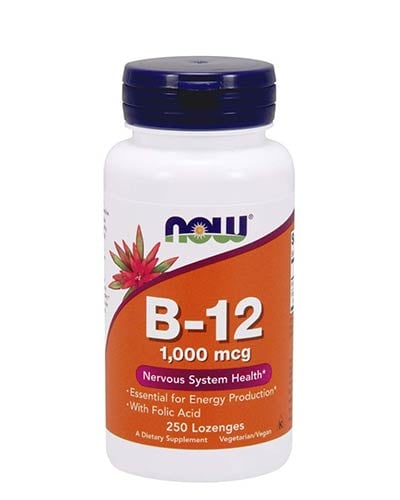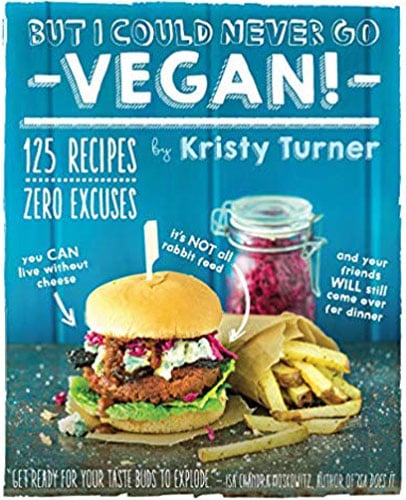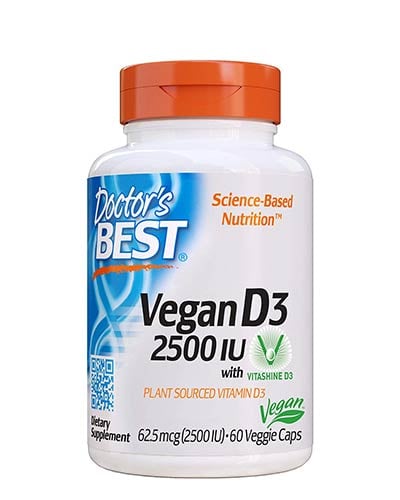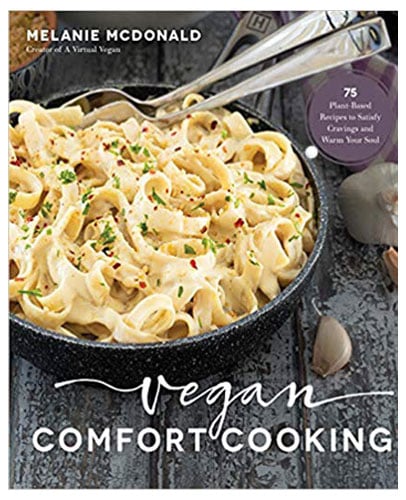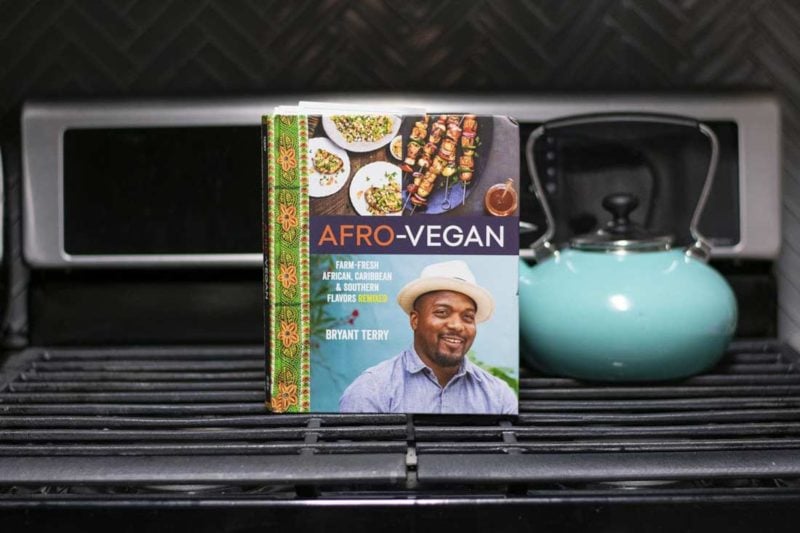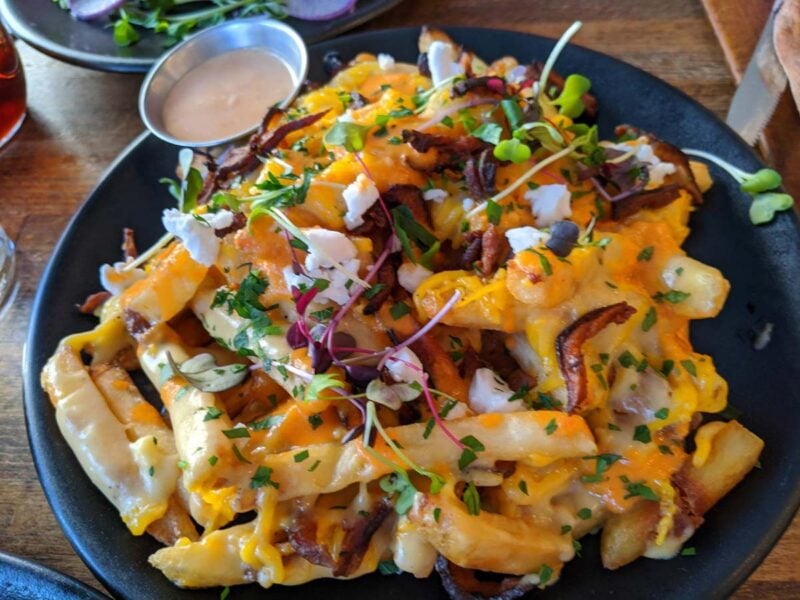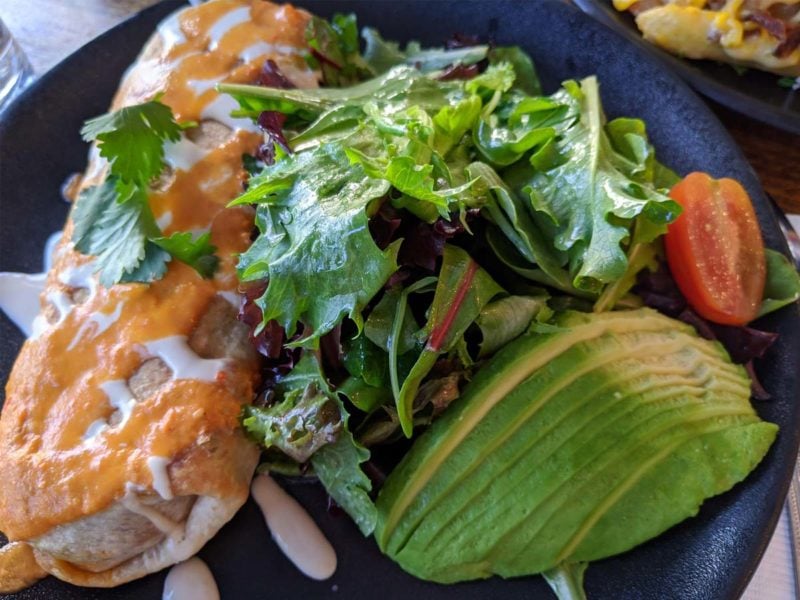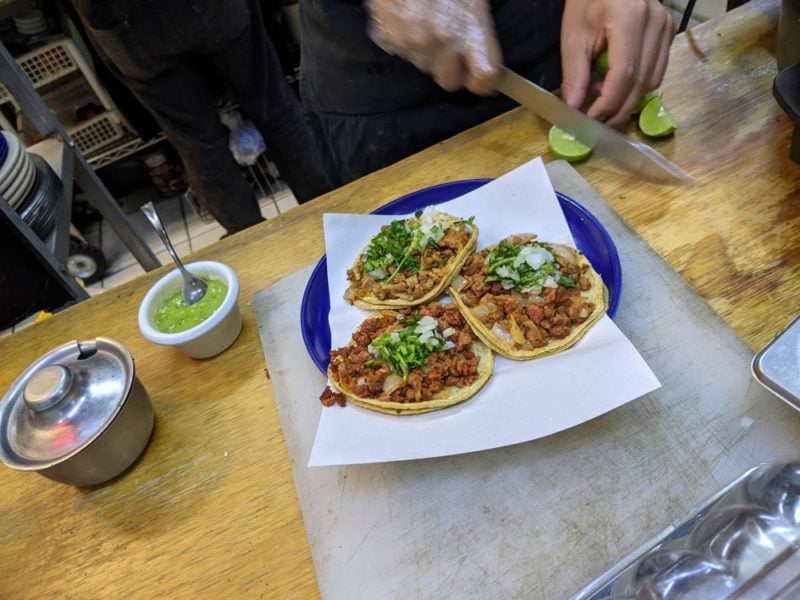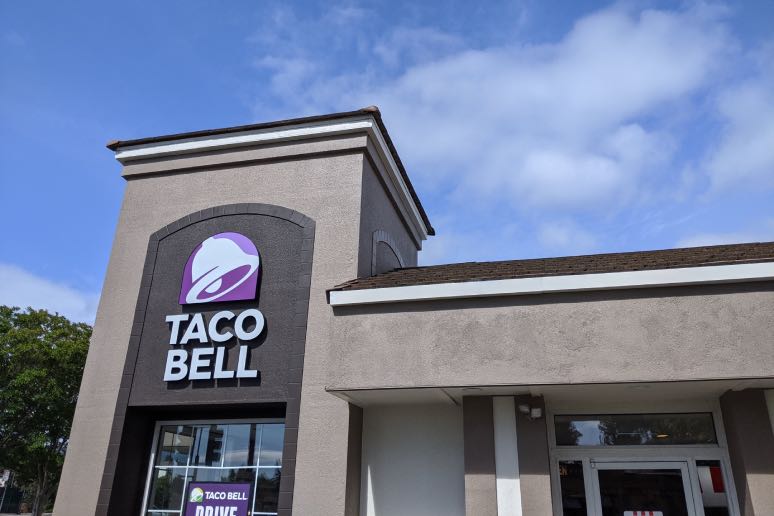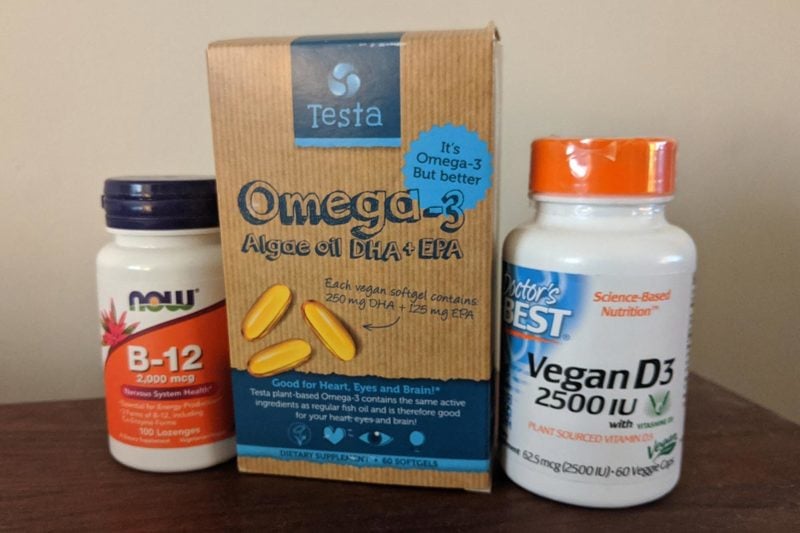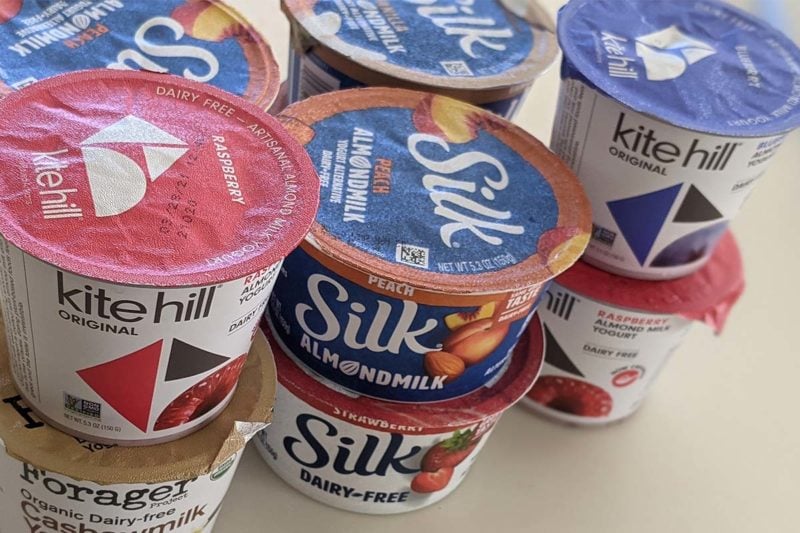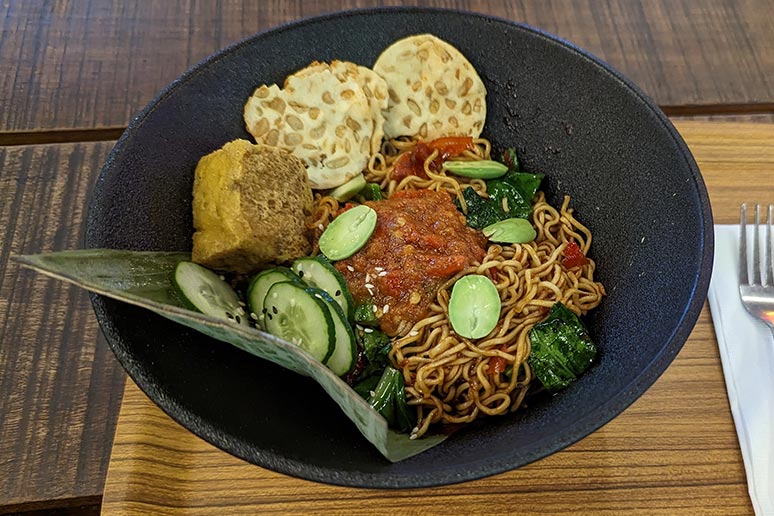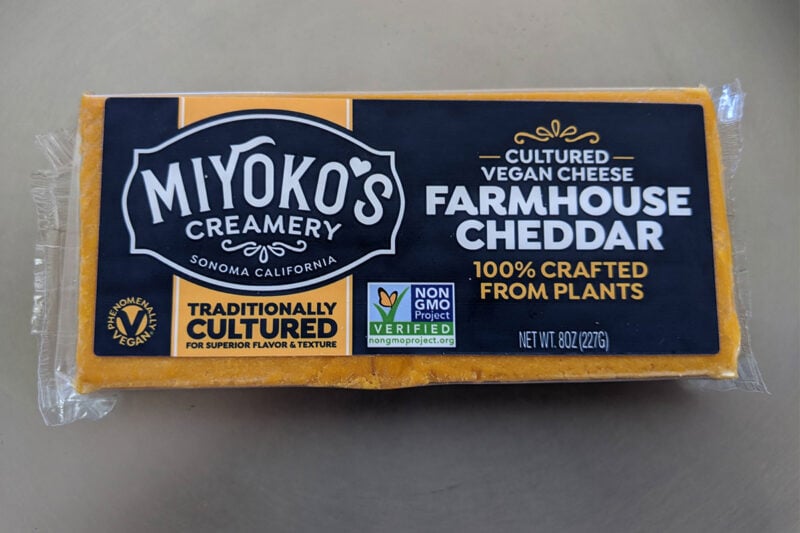If you’re on a tight budget, cheap and delicious vegan foods can save the day. It’s easy to eat cheaply as a vegan. In fact, if you want to eat well on a budget, no other diet compares.
Of course, meat eaters can eat cheaply too. The difference is that they often economize by buying low quality, unhealthy food. Canned Vienna sausages or off-brand hot dogs, anyone? By contrast, you can buy wholesome and delicious vegan foods at rock-bottom prices.
I feel especially well-qualified to teach you how to save money on a vegan diet, having spent decades needing to economize on food because full-time animal rights advocacy doesn’t pay the bills. Minimizing my food costs was the primary way I kept my head above water. In this article I will introduce you to the world’s cheapest and tastiest vegan foods. Over the years, these foods have saved me a fortune, and have enabled me to eat a wonderfully healthy diet.
Cook Foods from Scratch
Any effort to cut your food costs should begin with these two crucial steps:
- Avoid eating out. You can easily feed yourself for a week for the price of one mid-priced restaurant meal. Even fast food restaurants charge at least triple what it’ll cost you to make a meal at home. If you’re struggling financially, preparing food at home is a must.
- Don’t buy frozen convenience foods. Unlike vegans, meat eaters can purchase all sorts of cheap frozen processed foods. By contrast, vegan frozen foods use better ingredients and carry a huge premium. Frozen vegan pizza, for instance, often costs twice the price of non-vegan mass-market brands.
Fortunately, not all frozen vegan foods are overpriced. Frozen peas, corn, and spinach are quite inexpensive and generally excellent quality. Bagged frozen berries cost much less than fresh, plus they’re available year-round. These are all especially good foods to eat in the winter, when low-cost peak-of-season produce is unavailable.
There’s really only one junky vegan frozen food that’s cheap: fried potato products. Tater Tots and hash browns are accidentally vegan, and perhaps the cheapest items in the frozen food aisle.
If you’re going to avoid eating out and also avoid frozen convenience foods, you’ll obviously need some basic food prep skills. But don’t despair if you don’t know how to cook, or lack the time to prepare involved meals. Some of the best and healthiest vegan meals take only minutes to make. You can prepare a delicious sandwich in a couple minutes, or oven roast some vegetables in twenty minutes. Before we dive into meal ideas like these, let’s cover how to purchase food as cheaply as possible.
Grocery Shopping
You can buy inexpensive vegan food almost anywhere: supermarkets, natural food stores, farmers’ markets, and even Walmart.
Apart from gourmet specialty items, nearly any grocery item you buy will be vastly cheaper than restaurant food. Let’s now look at some low-cost healthy staples that belong in your diet.
Cheap but Nutritious Vegetables
All vegetables are of course vegan, and most are inexpensive. But they do vary considerably in price. The lowest-cost choices include:
Potatoes: This is the world’s cheapest vegetable. Russets are the most popular variety for baking, and red potatoes are superb for stir-fries and any fried potato dish. One of the most satisfying breakfast items is home fries: coarsely-chopped peeled potatoes fried in oil until golden, usually seasoned with garlic and ground pepper and maybe some rosemary.
Sweet Potatoes: A little more expensive than potatoes, but also richer in nutrients. When baked they take on a magnificent texture. Consider baked sweet potatoes one of the all-time great winter foods.
Cabbage: Nearly as cheap as potatoes. Unlike potatoes, cabbage is extremely nutrient-dense. What’s more, regular purple, red, or green cabbage heads that grow in tight balls will stay fresh in an airtight bag in your refrigerator for a couple months. Other cruciferous vegetables like broccoli and cauliflower cost triple the price but hardly last a week. Cabbage is delicious in stir-fries and is the main ingredient in coleslaw. Finely-sliced raw cabbage makes for a colorful and crunchy salad topping.
Carrots: Loaded with fiber and beta carotene. Excellent sliced and added to stir-fries. Or scrub thoroughly and cut into sticks and serve alongside hummus. Also terrific when grated for salad.
Onions: Among the cheapest of all vegetables, the most common varieties are yellow, red, and white. Yellow onions are invariably the cheapest. Every variety tastes about the same, aside from sweet Vidalia onions. Chopped onions browned in skillet are a magnificent addition to any dish from stir-fries to mashed potatoes to spaghetti sauce.
Leafy greens: Although more expensive than many vegetables, leafy greens are still affordable and they’re incredibly nutritious. Check the prices of spinach, collards, kale, and chard and buy whichever is cheapest. All of these choices are fantastic chopped and added in the final two minutes of cooking your stir-fry. Pre-washed spinach packed in big cellophane bags sells at an especially good price. And frozen spinach is cheap, high quality, and excellent in casseroles.
No matter where you buy your vegetables, pay attention to the price by weight, and make your purchases accordingly. Prices vary dramatically and often for no obvious reason. For instance, you might see yellow bell peppers selling for half the price of comparably nice red bell peppers.
Also remember to seek out produce items that are on sale. Supermarkets and natural food stores usually heavily discount a few particular produce items every week.
Vegetables offer outstanding nutrition and many types are remarkably cheap and easy to prepare. My guide to vegetables offers extensive and helpful coverage.
Vegan Staples
Let’s now look at some other healthy foods ideal for saving money.
Beans
Beans rank alongside leafy greens as the most nutritious of all vegan foods. They come in every size, shape, and color. Keeping several kinds of beans in your pantry is one of the easiest ways to add variety to your diet. Both canned and dried beans are imperishable and can be stored at least a couple years.
Dried beans are cheaper than canned and have better texture and flavor. Plus, dried beans are actually even cheaper than they appear since they more than double in size and weight during cooking. That’s a wonderful contrast to meat, which loses substantial volume and weight when cooked.
If you don’t have an Instant Pot or pressure cooker, canned beans can save you a lot of time and hassle. So don’t hesitate to buy canned beans for the sake of convenience. They still rank among the cheapest and healthiest foods available.
Every variety of bean features subtly different textures and flavors, so try as many as you can. See my bean guide to learn how to prepare and get the most out of this important food.
Finally, most grocery produce sections sell bagged mung bean sprouts, which are both protein-rich and super cheap. Bean sprouts are excellent in stir-fries (add them towards the very end).
Soyfoods
Cheap, loaded with protein, and endlessly versatile, tofu and tempeh belong on every budget-minded shopping list. These foods cost less than half the price of vegan burgers and sausages, and often deliver superior nutrition.
Natural food stores also carry TVP (textured vegetable protein), which is absurdly cheap. TVP is pure protein, featuring every essential amino acid. When mixed with water and sauteed in oil and spices TVP gains a texture and flavor profile similar to ground beef. You can season it with ground cumin and pepper to make a sensational meaty spaghetti sauce. Homemade vegan chili with black beans and TVP is probably the most delicious inexpensive protein-heavy dish on the planet.
Pasta:
From spaghetti to macaroni to lasagna, pasta takes a thousand forms. Nearly all dried pasta is vegan, and it’s one of the world’s cheapest foods. Top with some tomato sauce and some roasted veggies or sliced browned tempeh slices and you’ll have a cheap, nutritious, and filling meal.
Breads:
Breads and flatbreads come in countless varieties. I think making bread by hand is too time consuming when it comes to kneading and cleanup, but a bread machine does the job beautifully and can cut your bread costs by two-thirds. Bread from your local bakery is an affordable splurge. It’s much pricier than dried pasta, but still provides plenty of calories and decent nutrition at a reasonable price.
Roasted Peanuts and Sunflower Seeds
These cost about one-third the price of tree nuts yet offer comparable nutrition. They’re a fantastic garnish for both stir-fries and salads.
Hot Cereal
Any variety of porridge is one of the most delicious and satisfying breakfast possibilities, especially during winter. Hot cereals are remarkably cheap, and many varieties take just minutes to cook. Plus, unlike boxed breakfast cereal, hot cereals don’t require vegan milk, which may be beyond your budget. Any good natural food store will carry several varieties in its bulk section. Steel-cut oats take about fifteen minutes longer to cook than rolled oats, but their immensely satisfying texture makes them worth the wait.
Breakfast Cereal
Boxed breakfast cereals are surprisingly pricey. But most natural food stores sell premium organic breakfast cereals in economy-sized bags. They also commonly carry these breakfast cereals in their bulk department, once again at prices far below boxed brands. Regardless, hot cereal is always a much better deal.
Peanut Butter
Nutrient dense and cheap as can be. In addition to being great on toast and in sandwiches, it’ll make a fantastic peanut sauce to serve over rice. Buy a brand made only of peanuts and salt—this natural style of peanut butter is both tastier and better for you than mass-market brands, although you’ll need to stir it thoroughly and then refrigerate after purchase. This stirring is a little time-consuming and messy but you can make the task easier by inverting the sealed jar at room temperature for a couple days before stirring.
At many natural food stores, you can grind your own peanut butter using a machine in their bulk department—the oils won’t have time to separate if you refrigerate your peanut butter right when you get home. This saves you the hassle of stirring. This kind of peanut butter typically has a coarser texture than jarred brands, which some people prefer and others don’t.
Canned Tomatoes
You can buy canned tomatoes whole, diced, or made into sauce. Canned tomato sauce is often just as good as glass-jarred sauce, yet sells for half the price.
The Cheapest Places to Buy Groceries
Now that we’ve looked at the cheapest grocery items, let’s look into where to find the best deals. The key to saving money on vegan food is to shop in multiple places—the more places you shop at, the more great deals you will find.
Whenever possible, take some extra time to wander aimlessly around your favorite food market. It’s time well-spent. You’re bound to discover some tempting and affordable foods.
Supermarkets: Most supermarkets post their weekly circular at the entrance, so always pause there to see what’s on sale. You might find a great deal on a few fruits and vegetables that are normally out of your price range. Supermarkets typically offer an impressive produce section, and low prices on pasta, canned tomatoes, and bagged rice and beans. Unfortunately, most supermarket bread is neither good nor cheap.
Also note that when it comes to products like organic breakfast cereal or vegan ice cream, supermarket prices are generally terrible. Supermarkets usually sell these foods at list price, whereas your local natural food store typically strives to price them competitively.
Natural Food Stores: If you’re really trying to save money, you are unlikely to find great prices at natural food stores with two big exceptions: items that are on sale and anything in the bulk food department. These bulk departments typically offer unbeatable prices on beans, rice, nuts, cereals, and other healthy vegan foods.
Farmers’ Markets: Prices range from exorbitant to the best deals you’ll find anywhere. Always scout out the entire market before purchasing anything, since nothing’s worse than loading up on something and then finding an identical offering a few tables away for half price. Arrive in the final 30 minutes and you’ll often get sensational deals from farmers looking to unload their unsold perishable items.
Farmers markets enable you to buy fruits and vegetables at the peak of season, when they’re selling for next to nothing. You can lock in savings for months to come by freezing this produce for winter. For berries and sliced fruits, the IQF (individually quick freeze) method is the way to go. Just arrange your fruit in a single layer of a baking sheet, and put them in the freezer until rock-hard. Then transfer them to an airtight container or freezer bag for long-term storage. This freezing method keeps your fruit from clumping together into an unappetizing frosty brick. And because the fruit freezes much quicker when processed this way, it suffers less damage from the formation of ice crystals.
Ethnic Groceries: Find these in any good-sized city and even in some smaller towns. Whenever I visit these markets, I rarely see anyone not of that particular ethnicity. That’s a shame, since there are great deals to be had, as well as delicious vegan foods you won’t find anywhere else. Asian markets offer unbeatable prices on tofu, rice, soy sauce, hot sauce, and seaweed. Indian groceries are sensational for yummy bagged snacks, papadums, and pickle relishes. Most also sell freshly-made hot samosas and pakora for a pittance.
Gardening: Let’s not forget about growing your own food to save money. If you put a fair value on your time, the cost savings won’t be impressive. But if you enjoy gardening, you can count your gardening time as leisure and exercise. Regardless, you’ll end up with some of the best-tasting produce you’ll ever eat.
Zucchini, potatoes, and winter squash are some of the easiest and most productive crops. And of course, nothing compares to a tomato picked right from the vine. If your yard has room for some fruit trees, they’ll require much less maintenance than a vegetable garden.
If you don’t have a backyard suitable for gardening, some cities offer community gardens that rent tiny plots of land for next to nothing. You may also be able to work-trade at a local farm in exchange for fruits and vegetables. I once worked a few hours a week at a farmer’s market booth, and received half my pay in tomatoes and cantaloupes.
Save Money by Buying in Volume
Supermarkets and natural food stores often sell potatoes, onions, and carrots in large bags. Typically the price by weight is 50 to 70 percent less than buying these same foods loose.
You can also buy big bags of rice and beans at a steep discount. Find these at wholesale clubs like Costco, as well as Indian, Asian, and Mexican grocery stores. Oddly, supermarkets and natural food stores rarely carry beans and rice in large sacks.
If you can afford the annual membership of a Costco, Sam’s Club, or BJ’s, you can further cut your food bill while simultaneously expanding the variety of foods you eat. Thanks to the substantial discounts associated with buying in quantity, you may be able to purchase gourmet items and convenience foods you couldn’t otherwise afford.
It’s worth inserting here that, compared to individuals and small families, people living cooperatively enjoy an advantage when it comes to eating cheaply. Live with enough people and your group can get big discounts by buying food in wholesale quantities. I once lived at a co-op and a local farm made a weekly delivery. It was worth the farmer’s time to personally deliver these large orders, and we received his best prices.
Grocery stores catering to restaurants sell paint bucket sized cans of everything from tomato sauce to pickles to artichoke hearts. This is probably the cheapest possible way to buy food, but the quantities are too large for families not huge enough to have their own reality TV series.

Outfitting Your Kitchen
Properly outfitting kitchen will make you more inclined to cook at home. And the more cooking you do, the more money you’ll save.
There’s a saying in business that you need to spend money to make money. The same principle applies to cookware. When measured on a cost-per-use basis, even expensive cookware and appliances become cheap after a few years of daily use. These items are a one-time investment that can save you a fortune by enabling you to forgo packaged food and restaurant meals.
See my cookware page for the most useful items, along with notes on why each may deserve a place in your kitchen. You can find most of these items in thrift stores or flea markets for practically nothing. Think of these appliances not as expenses but as investments. Use a blender or toaster a few thousand times and its cost-per-use drops to less than a penny.
Since nearly everything I have to say about this topic is already on my cookware page, I won’t rehash the dozens of worthwhile cookware items here, but I do feel obligated to digress for a moment on the unsurpassed virtues of Instant Pots.
Instant Pots
You’re unlikely to find an Instant Pot at your local thrift store, since they’re so useful that nobody’s willing to give them up. But new ones don’t cost much, and you can find knockoffs at big box stores for half the price. No-name brands call these appliances “multi-cookers.” I urge you to do whatever it takes—beg, borrow, or steal if you must—to get your hands on an Instant Pot-type device.
That’s because Instant Pots are a game changer when it comes to preparing beans. Until my Instant Pot came along, I almost never cooked beans because the task involved too much time and hassle. Beans are annoying to cook on a stove-top, since they require babysitting, take forever to cook, and you have to listen to a clattering lid. But they’re among the most filling, nutritious, and cheap foods you could eat. They’re the main ingredient in refried beans, Indian dal, and hummus. Plus, they can go into all sorts of delicious soups and stews. An Instant Pot cooks your beans silently and perfectly in half the time, then shuts itself off and beeps when your food is ready.
Instant Pots are also the perfect way to cook steel-cut oats, which is probably the cheapest breakfast imaginable. If the convenience gained from an Instant Pot enables you to cook beans or steel-cut oats daily, it’ll put a dent in your food bill sufficient to pay for the appliance within just a few months. So the question really isn’t whether you can afford an Instant Pot, the question is whether you can afford not to own one?
Draw Cooking Inspiration Different Cultures
You’re certainly not the first person seeking to economize on food. Billions of people, from every part of the world, have needed to minimize their food costs. Let’s look at how they made do, so you can incorporate their best ideas into your own cooking.
In many cultures, there’s typically one particular staple that formed the foundation of that region’s diet. In Asia and India it’s rice, in Latin America it’s corn, in Europe it’s grains, and in Ireland it’s potatoes. What do all these staples have in common? They’re all cheap, satisfying, and filling. Less affluent people from these regions subsisted largely on these foods, including them in practically every meal.
Unfortunately, with the exception of grains, the above staples are calorie-dense but low in protein and many other other nutrients. Impoverished people who relied too heavily on these foods often suffered from nutrient deficiencies. Overindulgence in these foods (because other choices were unaffordable) is the primary reason that generations of Asians and Latin Americans tended to be much shorter than Westerners. That said, all of these foods have a place in your diet when eaten in moderation. And we can use our knowledge of modern nutrition to ensure a diet rich in traditional staples will meet your body’s needs.
The traditional staples we’ve just reviewed can go a long way toward cutting your food costs. As we’re about to see, these foods are the main ingredient of some of the world’s most delicious vegan dishes.
Asia: People throughout China and Southeast Asia commonly eat rice alongside stir-fried vegetables, tofu, and meat. Countless families throughout Asia eat rice daily, and many have a rice cooker in their kitchen. These appliances are almost a must-have if you love rice, since they streamline the task and do a perfect job every time.
Rice comes in dozens of varieties, and you can add diversity to your meals just by keeping several kinds of rice in your pantry. To get acquainted with this classic side dish and all its possibilities, see my guide to rice.
Most rice eaten in Asia is either jasmine or regular white rice, but brown rice is a much healthier choice for your home cooking (although it takes more than twice as long to cook). Asian nations also consume immense quantities of rice noodles, whereas this food is rarely eaten by Westerners. A popular variety of these noodles is called, “rice stick,” and you can buy these and other rice noodles at any Asian grocery or online. Note that because they lack gluten, they fall apart if boiled like pasta. Instead, they’re soaked for several minutes in hot water.
The most popular rice noodle dish in western countries is Pad Thai, which features sliced or shredded vegetables and a flavorful tamarind sauce. Although typically made with egg and fish sauce, it’s easily prepared vegan.
In Japan, a sticky form of rice is combined with seaweed, fish, or vegetables and made into sushi. Many Westerners think that sushi invariably contains fish, but the reality is that vegan sushi is common and delicious. If you’re new to sushi, I recommend starting with avocado nori rolls. You can get these at any sushi restaurant and a great many natural food stores. Vegan nori rolls, stuffed with avocado, natto, or finely-diced cucumber, are also easily made at home.
Latin America: Throughout Mexico and many Latin American countries, just about every restaurant meal is either made with corn tortillas or is served with tortillas on the side. My favorite Mexican breakfast is called enfrijoladas, and it’s diced potatoes wrapped by tortillas immersed in a thick black bean sauce. My Vegan Mexican foods guide features all sorts of classic dishes that include tortillas or tortilla chips.
Of all the world’s staples, corn is probably the least nutritious. That’s largely because its protein lacks an amino acid called lysine. But you can remedy this shortcoming by incorporating beans (which are loaded with lysine) into your corn-based dishes. See, for instance, the enfrijoladas dish mentioned above. Tacos topped with beans are probably the most popular protein-complete vegan meal served in Mexico. Accompanying tortilla chips with bean dip also gives you a complete protein.
Italy’s corn-based counterpart to tortillas is polenta. Super cheap and shaped like a fat sausage, better groceries carry it worldwide. You can slice it up and fry it, and serve it with sautéed vegetables in a spicy sauce.
Europe: The vast northern plains of Europe produce staggering quantities of wheat, and Russia alone grows nearly twice as much of this grain as the United States. Since wheat is significantly more nutritious than rice or corn, even the poorest Europeans had a nutritional advantage over people from other parts of the world. Throughout Europe, bread is a key food source. To this day, you’ll find superb bakeries in nearly every European town.
A slice or two of bread served alongside soup or a salad will add sufficient heft to your meal to keep you from getting hungry an hour later. And sandwiches might be the single most valuable meal for people moving toward plant-based diets, since they’re easily made in any number of ways.
Ireland: This country has endured centuries of political oppression and poverty. During its darkest periods, millions of Irish subsisted primarily on potatoes—much to their detriment since this food is low in protein and other nutrients. To boost nutrition and flavor, the Irish often cooked their potatoes along with breadcrumbs, dairy products, and eggs.
Potatoes remain among the world’s cheapest foods. When not eaten to excess, they can round out your diet and simultaneously reduce your overall food costs. Anytime you’re heating up your oven, just throw in a couple potatoes (scrubbed and punctured a few times with a fork) and they’ll make a terrific accompaniment to almost any meal.
You can prepare potatoes in so many ways. If you’re a novice cook, try russets first. They’ve got the perfect texture for baking. If you’re frying potatoes in a pan, perhaps as a stir-fry ingredient, go with red potatoes. Cooked green peas are the classic Indian accompaniment to chopped, boiled, curried potatoes. Home fries and hash browns are two more delicious and vegan-friendly potato-based dishes.

Cheap and Easy Meals to Make at Home
Some of the cheapest vegan meals are neither fussy nor time-consuming. And you can make them in countless variations. I call these meals “core foods.”
You can read my guides to preparing each of them:
- Stir-Fried Vegetables
- Salads
- Roasted Vegetables
- Sandwiches and Wraps
- Soups and Stews
- Sweet and Savory Bowls
Additionally, any sort of rice and bean dish makes a cheap and delicious meal. The variations are endless, since you can constantly change up the rice, the beans, and the spices.
And of course, spaghetti and marinara sauce is a classic budget meal. A little shredded vegan cheese added just before serving is delicious. If vegan cheese is out of your budget, a sprinkling of nutritional yeast offers a much cheaper way to add some cheesy flavor notes.
Both bean dishes and spaghetti go great with caramelized onion. Just chop a yellow onion and fry it in a skillet with some olive oil over low/medium heat, frequently turning with a spatula. It takes about twenty minutes to brown the onion sufficiently.
If you never buy a single cookbook and rely only on the above suggestions, you’ll still have everything you need to eat a healthy and diverse vegan diet. To venture beyond these basics, please see my vegan cooking guide, or pick up one of the recommended cookbooks in the following section.
Cookbooks for Eating Vegan on a Budget
Several vegan cookbooks focus exclusively on low-cost recipes. These cookbooks make use of cheap and healthy ingredients like beans, whole grains, and inexpensive varieties of vegetables:
- Bosh on a Budget, by Firth & Theasby
- Broke Vegan, by Saskia Sidey
- The Budget-Friendly Vegan Cookbook, by Ally Lazare
- Fast Easy Cheap Vegan, by Sam Turnbull
- Vegan on a Budget, by Nava Atlas
- Frugal Vegan, by Koteen & Kasbee
But keep in mind that almost any meal you prepare from scratch is cheaper than buying packaged foods or eating at restaurants. So if there’s a particular style of vegan cooking that interests you, by all means invest in a cookbook devoted to it.
My recommended vegan cookbooks page covers the best recent titles for practically every niche.
Avoid Buying Lunch at Work
Many people who enjoy cooking at home needlessly blow a lot of money during their lunch hours.
It’s easy to succumb to buying prepared food during your lunch break, especially if you feel chronically pressed for time. But those meal purchases quickly add up. Luckily, vegans face fewer temptations to buy lunch since the take-out and dining options near their employment are often limited. So instead, just pack a simple lunch and bring it with you. It takes only a few minutes to prepare something that’s tastier, better for you, and cheaper by far than any food you can purchase during your lunch break.
My lunch page offers all sorts of terrific ideas for packing lunches for work. And I’ve also written a school lunch page featuring delicious possibilities for children.
Preventing Food Waste
Minimizing food costs requires the groceries you buy to make it into your stomach. To keep nothing from going to waste, cultivate these habits:
- When you arrive home with your groceries, prepare your most perishable purchases first—don’t even put them into the refrigerator! The vegetables you just purchased will never get any fresher. So make a vegetable-heavy meal right away, prioritizing greens and other highly perishable vegetables. The vegan ice cream you just bought can wait!
- For any vegetables you don’t eat right away, promptly refrigerate them in an airtight bag or container. The easier your vegetables are to use at a moment’s notice, the less likely they’ll go to waste.
- Consider making salads for an entire week. You can use meal-sized airtight plastic containers. Making five servings of salad takes scarcely more time than a single serving requires. And having pre-made salads on hand will makes them an easy choice the next time you’re hungry. But never add the dressing until you’re ready to eat, since salad greens that come in contact with dressing wilt within hours.
- Never throw away your broccoli stems! Just skin and chop them, and they’re superb in soups or stir-fries. They require a little less cooking time than root vegetables chopped to comparable size.
- At least once a week, go through your refrigerator and pantry to prioritize eating any items that you’ve forgotten about.
- Buy a cheap soft heat-resistant silicone spatula. That’ll enable you to get every last bit of food out of jars and your blender, saucepans, and mixing bowls.
Learn the Basics of Nutrition
Eating on a budget doesn’t require compromising your nutrition. It’s absolutely possible to consume abundant nutrients at low cost. Many of the healthiest vegan foods are remarkably cheap.
When it comes to nutrition, it’s wise to eat plenty of beans, soyfoods, and vegetables, since these foods are extremely nutrient-dense.
Consider it mandatory to also read up on the basics of vegan nutrition. The most authoritative introduction to the topic is our vegan nutrition primer written by Virginia Messina, MPH RD. It’ll give you an overview of the main dietary pitfalls that vegans need to avoid.
For a few nutrients, particularly Vitamins D and B12, supplements offer the easiest way to cover your needs. Check out the preceding links for details, and also visit my guide to supplements. Luckily, most supplements of special interest to vegans are remarkably cheap.
If you don’t take a daily multivitamin, use iodized salt for your cooking. More than two billion people worldwide fall short on iodine, often suffering serious health consequences. Fortunately, regularly cooking with iodized salt should cover your needs.
Random Money-Saving Tips
Here are the most important ideas I’ve brought up in this piece, plus a few new ones thrown in for good measure:
- Never buy bottled salad dressing. You can make your own in barely two minutes for one-fourth the price, and it’ll be tastier and fresher.
- Favor brown rice and whole grain breads and pastas most of the time. Whole grains don’t cost more, but deliver better nutrition.
- Beans and peanuts are your cheapest sources of protein, and they’re rich in other nutrients too.
- Natural foods stores usually have better prices than supermarkets on packaged vegan food, and their bulk departments offer some of the best deals you’ll find anywhere.
- Bagged frozen fruits and vegetables can cheaply boost your nutrition, especially during winter.
- Whether it’s a toaster, rice cooker, or bread machine, any home appliance can quickly pay for itself by keeping you out of restaurants. An Instant Pot or similar multi-cooker is the most versatile and useful appliance you can buy.
- You need never pay for recipes. Recipes found online may disappoint, but your local library probably carries a stack of excellent vegan cookbooks.
Eating Vegan on the Cheap is Easy
One of the most common objections people make concerning veganism is that it’s a diet for the privileged. But as we’ve seen, that’s simply not the case. No other diet emphasizes such a wide variety of dirt cheap yet nutritious foods.
Of course, there are people around the world who don’t have access to many of the foods I’ve recommended in this article. So it’s unrealistic to assert that a vegan diet is easily accessible to everyone. But if you’re living in a developed country and you want to eat cheaply, the options we’ve explored here are a fantastic way to go. The reality is you can eat a day’s worth of nutritious food for scarcely more than what some people spend on a latte at Starbucks.
The name of the game is to stay out of restaurants and to resist the temptation of packaged convenience foods. You have so many other possibilities. When it comes to saving money, a few key measures make all the difference. Shop in several places to get the best deals. Buy in bulk whenever you can. Rely on inexpensive appliances to cut your food prep time, while expanding the variety of foods you’re able to prepare. Avoid food waste by preparing your perishable foods as soon as you bring them home, and taking a weekly inventory of your refrigerator.
These easy steps will enable you to reduce your food costs while maximizing variety, enjoyment, and nutrition.


